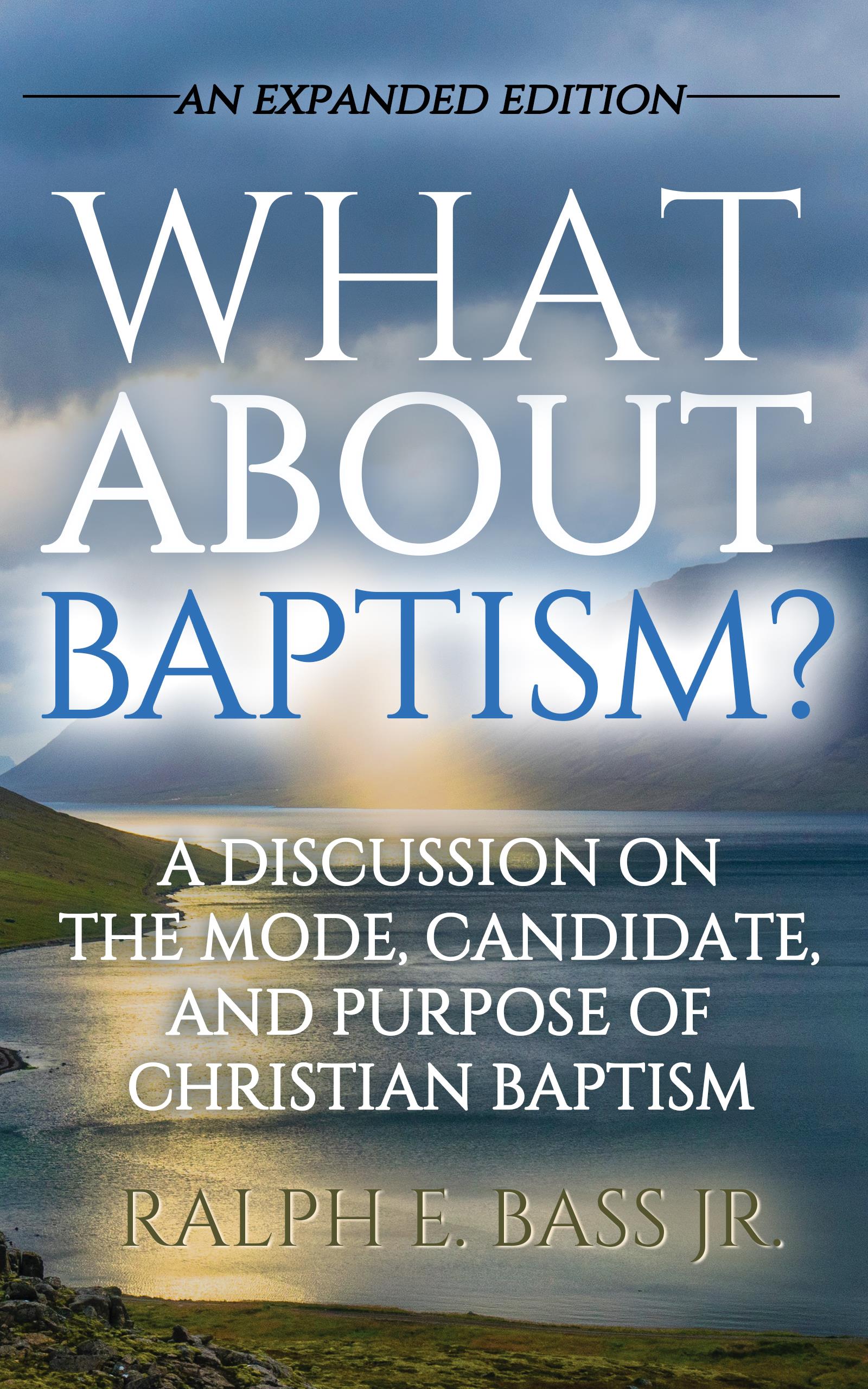
Hi, My Name Is Ralph Bass...This Is My Library


Subscribe to this Site
Some Objections to Dipping
Lord.” It is a very solemn, serious, and spiritual occasion in which God’s blessings are requested, dedications given, and commitments are made for the family to be God’s people and He to be their Lord. One Baptist writer who performs dedications admits, however, that “…’there is no divine authority for such services’ and one wonders how real consolation can be gained from them without recognition of that promise of the Lord which shows he accepts believers’ children into the fellowship of His church.”[1 ]
“In my view, infant dedication among Baptists is a kind of baptism without water.”[2] As much as one can appreciate the sincere desire of these dear Christians to dedicate their children to the Lord, nevertheless, it is not appropriate to do it in this way. A person does not create his own sacraments; he accepts the ones God Himself has given for these very purposes. Biblical baptism fills this role of Dedication, but it does so as the approved sacrament of the Lord. The children and the family are set aside to be God’s people and He to be their Lord, and this is done in the Scripturally approved format of covenant (infant) baptism.
However, for those that choose not to dedicate their children, the results are even worse. “…rather than including the children of believers in God’s visible covenant community, Baptists place their children in the pagan community.”[3] He means by this, they leave them outside the membership of the Church.
Let's Look Inside
the Book


Immersion Baptism and Dedication of Children
Dippers often have an instinctive sense that something is wrong when their children are left out of the membership of the church. Very often, this will reflect itself in the creation of a sacrament, which they call Dedication, to fill the spiritual gap this produces. Although opposed to infant baptism, they practice ‘infant dedication’ in its place. Now, there is no Scriptural warrant for this practice, and indeed there is something very wrong with adding to the two sacraments given to us by the Bible this sacrament of Dedication. Of course, I am not saying that those that advocate immersion baptism claim that they are creating a sacrament. However, if it walks like a duck, quacks like a duck, and flies like a duck, it probably is a duck. In other words, the elements of a Dedication illustrate a sacrament. For instance, those that practice immersion baptism gather with their children, in front of witnesses and before the church. The pastor, in his role as pastor, is presiding, prayers are said, and commitments are made to raise their children in the “nurture and admonition of the
Dippers often have an instinctive sense that something is wrong when their children are left out of the membership of the church. Very often, this will reflect itself in the creation of a sacrament, which they call Dedication, to fill the spiritual gap this produces. Although opposed to infant baptism, they practice ‘infant dedication’ in its place. Now, there is no Scriptural warrant for this practice, and indeed there is something very wrong with adding to the two sacraments given to us by the Bible this sacrament of Dedication. Of course, I am not saying that those that advocate immersion baptism claim that they are creating a sacrament. However, if it walks like a duck, quacks like a duck, and flies like a duck, it probably is a duck. In other words, the elements of a Dedication illustrate a sacrament. For instance, those that practice immersion baptism gather with their children, in front of witnesses and before the church. The pastor, in his role as pastor, is presiding, prayers are said, and commitments are made to raise their children in the “nurture and admonition of the
Immersion Baptism and Dipping as a Symbol of Burial
The immersion baptism formula of “buried in the likeness of His death, raised in the likeness of His resurrection” draws home the central element of dipping, burial. This is what going down into the water is supposed to signify--being buried. Coming out of the water in turn signifies resurrection from this buried state. So, the heart and soul of the dipper’s rite is the symbol of the death, burial, and resurrection of Christ.
Of course, Christ was not buried in a hole in the ground, but was placed in a cave or tomb. Therefore, from the start, dipping misses the mark, and is therefore a false picture. But another point of some significance needs to be made. It is the fact that the burial of Christ is not a major element in our doctrine of salvation. Christ’s substitutionary death by crucifixion is a critical element of our salvation, but dipping does not portray this at all. In addition, His conquering death in His resurrection demonstrates His power over death, and thereby His ability to raise us up on that last day. This also is central to our faith. These two points are beyond measure in their importance.
But what significance does the burial of Christ in a tomb have? If He had been buried in a hole in the ground and covered with dirt, as the immersion baptism advocates seem to believe, would that have changed any aspect of His saving power? If He had been buried in a pyramid, or on a tree stand like the American Indians, would that have made a difference? The fascinating point is that it does not appear to be at all consequential how He was buried. And yet this is the only real point that dipping makes, His burial. This point, which the Bible passes over with no theological import, is the one and only point dipping makes with force. But, that being the case, since the Bible makes little of it, why should we make much of it? And indeed, why is the picture of His burial made to be so incredibly important by the dipper? This is an especially important question, since Christ was not buried in a hole in the ground and covered with dirt.
Now the next time an advocate of immersion baptism tells you that Christian baptism portrays the death, burial and resurrection of Jesus as them 1) was Jesus buried in a hole in the ground and covered with dirt? 2) And, what death, burial, and resurrection did John the Baptist’s baptism portray? If the answer to the first question is “no” and the second is “none,” and it certainly is, then we must conclude that death, burial, and resurrection are not central to the act of baptism at all. In fact, they are not even a part of it, let alone central to it! John certainly had had something else in mind. Just what did John have in mind? It was ceremonial purification, a change of condition from impurity to purity. John the Baptist was John the Purifier. And Baptidzo was the perfect work to make that point, for change of condition is exactly what the word addresses and it does so by any one of various modes.
-----------------------------------------------------------------
[1] Ward, Rowland S., pg. 71.
[2] Poythress, Vern Sheridan, V59#2, Fall 1997, pg. 144.
[3] Booth, Robert R., Children of the Promise, Presbyterian and Reformed Publishing Co., Phillipsburg, NJ, 1995, pg. 128.
The immersion baptism formula of “buried in the likeness of His death, raised in the likeness of His resurrection” draws home the central element of dipping, burial. This is what going down into the water is supposed to signify--being buried. Coming out of the water in turn signifies resurrection from this buried state. So, the heart and soul of the dipper’s rite is the symbol of the death, burial, and resurrection of Christ.
Of course, Christ was not buried in a hole in the ground, but was placed in a cave or tomb. Therefore, from the start, dipping misses the mark, and is therefore a false picture. But another point of some significance needs to be made. It is the fact that the burial of Christ is not a major element in our doctrine of salvation. Christ’s substitutionary death by crucifixion is a critical element of our salvation, but dipping does not portray this at all. In addition, His conquering death in His resurrection demonstrates His power over death, and thereby His ability to raise us up on that last day. This also is central to our faith. These two points are beyond measure in their importance.
But what significance does the burial of Christ in a tomb have? If He had been buried in a hole in the ground and covered with dirt, as the immersion baptism advocates seem to believe, would that have changed any aspect of His saving power? If He had been buried in a pyramid, or on a tree stand like the American Indians, would that have made a difference? The fascinating point is that it does not appear to be at all consequential how He was buried. And yet this is the only real point that dipping makes, His burial. This point, which the Bible passes over with no theological import, is the one and only point dipping makes with force. But, that being the case, since the Bible makes little of it, why should we make much of it? And indeed, why is the picture of His burial made to be so incredibly important by the dipper? This is an especially important question, since Christ was not buried in a hole in the ground and covered with dirt.
Now the next time an advocate of immersion baptism tells you that Christian baptism portrays the death, burial and resurrection of Jesus as them 1) was Jesus buried in a hole in the ground and covered with dirt? 2) And, what death, burial, and resurrection did John the Baptist’s baptism portray? If the answer to the first question is “no” and the second is “none,” and it certainly is, then we must conclude that death, burial, and resurrection are not central to the act of baptism at all. In fact, they are not even a part of it, let alone central to it! John certainly had had something else in mind. Just what did John have in mind? It was ceremonial purification, a change of condition from impurity to purity. John the Baptist was John the Purifier. And Baptidzo was the perfect work to make that point, for change of condition is exactly what the word addresses and it does so by any one of various modes.
-----------------------------------------------------------------
[1] Ward, Rowland S., pg. 71.
[2] Poythress, Vern Sheridan, V59#2, Fall 1997, pg. 144.
[3] Booth, Robert R., Children of the Promise, Presbyterian and Reformed Publishing Co., Phillipsburg, NJ, 1995, pg. 128.
















































































































